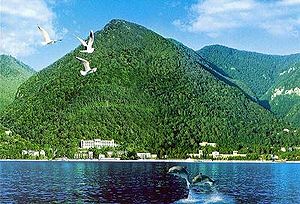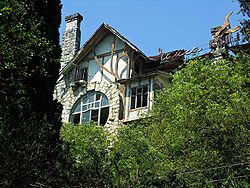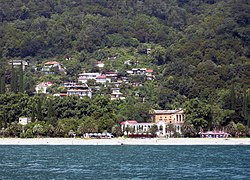This is an old revision of this page, as edited by Alaexis (talk | contribs) at 16:32, 5 September 2007 (removed passage that didn't contain any real info; increasingly decrepit is plainly wrong). The present address (URL) is a permanent link to this revision, which may differ significantly from the current revision.
Revision as of 16:32, 5 September 2007 by Alaexis (talk | contribs) (removed passage that didn't contain any real info; increasingly decrepit is plainly wrong)(diff) ← Previous revision | Latest revision (diff) | Newer revision → (diff)| This article does not cite any sources. Please help improve this article by adding citations to reliable sources. Unsourced material may be challenged and removed. Find sources: "Gagra" – news · newspapers · books · scholar · JSTOR (August 2007) (Learn how and when to remove this message) |

Gagra (Abkhaz and Russian: Гагра, Georgian: გაგრა) is a city in Abkhazia, the breakaway republic of Georgia, sprawling for 5 km on the northeast coast of the Black Sea, at the foot of the Caucasus Mountains. Its subtropical climate made Gagra a popular health resort in Imperial Russian and Soviet times.
It had a population of 26,636 in 1989 but this has certainly fallen considerably due to ethnic-cleansing and mass expulsion of ethnic Georgians from Abkhazia.
Gagra is the centre of the district of the same name. It is located in the western part of Abkhazia and river Psou serves as a border with Krasnodar Kray of Russia.
History
The city was established as a Greek colony called Triglite, inhabited by Greeks and Colcians. It came under the control of the kingdom of Pontus in the 1st century BC before being absorbed by the Roman Empire, which renamed the city as Nitica. Its geographical position led the Romans to fortify the city, which was repeatedly attacked by Goths and other invaders. After the fall of Rome, its successor, the Byzantine Empire, took control of the city. Along with the rest of Abkhazia, Gagra was incorporated into the Georgian kingdom of Imereti from the 9th century onwards. It became a major trading settlement in which Genoan and Venetian merchants were prominent, trading in the city's main exports - wood, honey, wax and slaves. The name "Gagra" appears for the first time on a map of 1308 made by the Italian Pietro Visconti, which is now in the Library of Saint Mark in Venice.
Gagra under the Russians

In the 16th century, Gagra and the rest of Abkhazia was conquered by the Ottoman Empire. The western merchants were expelled and the city entered a prolonged period of decline, with much of the local population fleeing into the mountains. By the 18th century the city had been reduced to little more than a village surrounded by forests and disease-ridden swamps. Its fortunes were restored in the 19th century when the Russian Empire expanded into the region, annexing Abkhazia. The swamps were drained and the town was rebuilt around a new military hospital. Its population, however, was still small: in 1866, a census recorded that 336 men and 280 women, mostly local families or army officers and their dependents, lived in Gagra. The town suffered badly in the Russo-Turkish War, 1877-1878, when Turkish troops invaded, destroyed the town and expelled the local population. Russia won the war, however, and rebuilt Gagra again.

After the war, the town was "discovered" by Prince Peter of Oldenburg, a member of the Russian royalty. He saw the potential of the region's subtropical climate and decided to build a high-class resort there. Having raised a large sum of money from the government, he built himself a palace there and constructed a number of other buildings in an eclectic variety of styles from around Europe. A park was laid out with tropical trees and even parrots and monkeys imported to give it an exotic feel. Despite the expensive work, the resort was not initially a success, although it did later attract a growing number of foreign tourists visiting on cruises of the Black Sea.
Gagra under the Soviet Union
In the Russian Revolution of 1905, a local uprising produced a revolutionary government in the town, which founded a short-lived Republic of Gagra. This was soon defeated and the revolutionaries arrested en masse. The First World War a few years later was a disaster for Gagra, destroying the tourist trade on which it depended. The Russian Revolution shortly afterwards saw the Bolsheviks take over the city; despite a brief French attempt to repel them during the Russian Civil War, the city was firmly incorporated into the new Soviet Union.
The Bolshevik leader, Lenin, issued a decree in 1919 establishing a "worker's resort" in Gagra, nationalising the resort that had been built by Oldenburg. It became a popular holiday resort for Soviet citizens and during World War II gained a new role as a site for the rehabilitation of wounded soldiers. After the war, various state-run sanatoriums were built there. The resort grew and was developed intensively as part of the "Soviet Riviera".
Gagra in separatist Abkhazia

In the late 1980s, tensions grew between the Georgian and Abkhazian communities in the region. All-out war erupted between 1992-1993 which ended in a catastrophic defeat of the Georgian government's forces. Hundreds of thousands of ethnic Georgians were expelled from their homes in Abkhazia in an outbreak of mass ethnic cleansing in which tens of thousands Georgian civilians were brutally massacred. Gagra and the Abkhazian capital Sukhumi were at the centre of the fighting and suffered heavy damage.
The conflict has still not been resolved, although ongoing skirmishes are confined to the Abkhazian/Georgian administrative border well to the east of the city.
Monuments

The chief landmarks of Gagra are:
- ruins of the Abaata fortress (4th-5th cent. AD);
- 6th-century church, said to be the oldest in Abkhazia;
- Marlinsky defensive tower (1841);
- 19th-century palace of the Prince of Oldenburg.
See also
External links
43°20′N 40°13′E / 43.333°N 40.217°E / 43.333; 40.217
| Administrative divisions of Abkhazia | |
|---|---|
| Districts | |
| Cities | |
| Towns | |
| Other settlements | |
| See also: Administrative divisions of Georgia | |